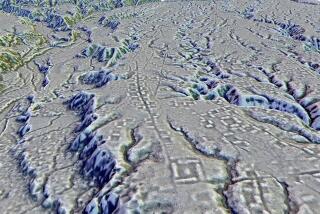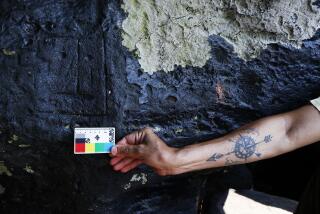Exploring the Restless Amazon
LETICIA, Colombia — You would hardly call it a bucolic landscape. Seen from the air, the Amazon curls in wide restless bands and silted oxbows deep into a wilderness of matted vegetation. Clouds cling in sullen shreds to the tops of giant palms.
Fed by tributaries draining half a continent, the mighty river--largest on earth--spreads like a branching artery from the Peruvian Andes 4,000 miles through Colombia and Brazil to the Atlantic Ocean.
In the vast equatorial flood plain falling back from its muddy waters live tens of thousands of species of trees and perhaps half of the world’s varieties of birds.
Indians roam the shadowy rain forest, fishing from dugout canoes or hunting sloths and monkeys with curare-tipped blowgun darts. Deadly piranhas infest a labyrinth of marsh-fringed lakes.
Arriving by Air
Until a few years ago the river attracted only the hardiest adventurers. Now all that has changed. With the advent of fast, efficient air service, Amazon travel has been brought within reach of U.S. gateways.
For exploring a representative corner of this jungle wonderland, Leticia, a Colombian outpost, provides a convenient and reasonably comfortable base.
My plane skimmed low over a tangle of lianas and fronds, circled the river and settled onto an asphalt airstrip. I stepped out into a blast of sweltering air.
Leticia lay in the crook of the river at the open, unpatrolled border between Colombia, Brazil and Peru. It’s a frontier town. Indians and mestizos spilled out onto a main street of tin-roofed shops. Rumba or rock blared from every doorway.
At river’s edge, fish vendors hawked golden-hued pez dorado , a staple of the Amazon. Heaped high in stalls were limes, plantains and papayas. Dogs scratched, chickens pecked. A right turn took me out over the water onto a wooden catwalk lined with dingy bars. At the foot of the makeshift pier my Amazon outing properly began.
River Shuttle Fleet
There are fewer than 15 miles of road in and around the town, so touring is by boat. A flotilla of dugouts and outboards waited at the catwalk to shuttle visitors up and down the river. A roomy fiberglass runabout with guide and Indian driver sped me away into the setting sun.
For my introductory cruise we swung around the river in a lazy arc, then headed toward a solid wall of green. Finding a gap, the driver worked through a grotto of vines to an open swamp.
The water was black with suspended humus. Lily pads five feet across floated like stepping stones near the shore, where dazzling white egrets dipped for fish.
At dusk the sky darkened to a dome of electric blue. Clouds tinged with pink and primrose massed on the western horizon. Heat lightning flickered, promising rain. We tunneled back to the Amazon and headed for Leticia.
The town’s top hotel, the Parador Ticuna, has a seedy tropical charm. Its plain, motel-style rooms smelled strongly of mosquito spray. It has a screened-in bar and an open dining patio under a thatched roof.
The menu offered a choice of steak, chicken or pez dorado . The fish, lightly fried, was delicious with an accompaniment of lime.
Rain Makes an Entrance
That night the rain began as a muffled drumbeat. Soon it coursed off the roof in sheets. A rivulet formed at my window, flowed down the wall and spread in a pool next to the bed. The rain continued without letup into the hours before dawn.
That made the morning air damp and soft. Under a leaden sky our boat rambled north, hemmed in by luxuriant greenery, a primordial world brightened by gorgeous blossoms of mauve, red and yellow.
At the southern tip of Yahuma Island we struck off west into a Peruvian tributary of the Amazon, the Cayaru River.
We passed towering cathedrals of trees and open-sided shacks with hammocks slung from their ridge poles. Women with high brown cheekbones and hair as black as polished basalt scrubbed clothes in the shallows.
A Ticuna Indian settlement called Bellavista sprawled at the head of the Cayaru, and we nosed up to the river bank. The Indians stared at us impassively, their cotton clothing faded and patched.
Salt and Cookies
An old woman turned manioc --a starchy root flour--over a wood fire. A boy wielding a machete hacked a leaf-shaped paddle blade from a slab of cedar.
We had brought salt for the adults and cookies for the children. One of the Ticunas presented us with sugar cane to gnaw, its woody pulp crushing to a saccharine but refreshing juice.
By midday the sky had cleared. The sun blazed like a molten penny; the heat became unbearable. We retreated to the Colombian side of the Amazon.
As we edged along the shady bank our driver veered through a narrow inlet that broadened to a secret lagoon overhung with a canopy of leaves.
Climbing ashore, we found ourselves in a clearing flanked by an avenue of ramshackle huts on stilts.
This was a village of the Yaguas, one of the more primitive tribes still scattered about the Amazon basin. It was a place out of time. Some of the women wore nothing but grass skirts. The smaller children--bellies swollen with parasitic diseases--wore nothing at all.
Handcrafts for Pennies
The rare visitor who wanders this way is treated to a stunning display of native handcrafts: delicately beautiful necklaces of shells, feathers, seed pods, dried fish scales, iridescent beetle carapaces--all sold for pennies.
A dollar or two will buy a blowgun and dart quiver or a net bag woven of vegetable fibers and dyed with berry juices.
The children, like their Ticuna counterparts, were shy and unsmiling. But when splashing near our boat they laughed and shouted like children everywhere, their bodies bright as varnish in the dappled light.
On our last day on the river we explored the hidden marshes north of Leticia. Poking into a lake rimmed by jungle--it was called Tarapoto--we drifted close to shore. Our driver scanned the bank.
In a little while he found what he was looking for. Holding onto branches, he pulled the boat into a dark, airless glade.
Around us was a drowned forest twined with lianas. The water, black and still, reflected patches of sky and elongated tree trunks. We seemed to float on air.
Shafts of sunlight fell in pools of acid green. Sweat ran down our faces. Tiny piranhas, whose razor-sharp teeth can almost instantly strip the flesh from a hand or an arm, darted like skates just below the surface.
The only sound was our voices; the only movement the filmy blur of fish and insects. We had stumbled on a lost Eden: a scene of haunting but forbidding beauty and solitude. We lingered spellbound, reluctant to leave.
Late in the afternoon a smudge of charcoal obliterated the sun. We hurried full-throttle back to the Amazon, rain gusting behind us like billowing smoke.
Day had become night. In the immensity of the river we were a racing speck, swept before the storm under the lee of the north bank.
We raced for Leticia. Soon the lights of the town beamed their welcome out of the murk.
-- -- --
Tours to the Colombian Amazon are offered by Turamazonas, 855 U.S. Highway 19 South, Suite A-1, Tarpon Springs, Fla. 33589; phone (813) 942-2533.
Costs per person start at $365 for a five-day package that includes meals, lodging (two hotel nights in Bogota, the capital; three in Leticia), airport transfers and boat excursions.
Round-trip air fare on Avianca is $1,116 from New York, $948 from Miami and $1,156 from Los Angeles.
Visitors who prefer to go on their own can book rooms at Leticia’s two main hotels, the Parador Ticuna and the Anaconda, through travel agents in Bogota or by writing directly.
The address in each case is simply Leticia, Colombia. The double room rate at both is $50. Each hotel will arrange guided Amazon River tours for about $75 a day. Expect to pay $7 for lunch or dinner in the hotel restaurants.
The Colombian Government Tourist Office, 140 East 57th St., New York 10022, phone (212) 688-0151, will provide additional details.
More to Read
Sign up for The Wild
We’ll help you find the best places to hike, bike and run, as well as the perfect silent spots for meditation and yoga.
You may occasionally receive promotional content from the Los Angeles Times.






